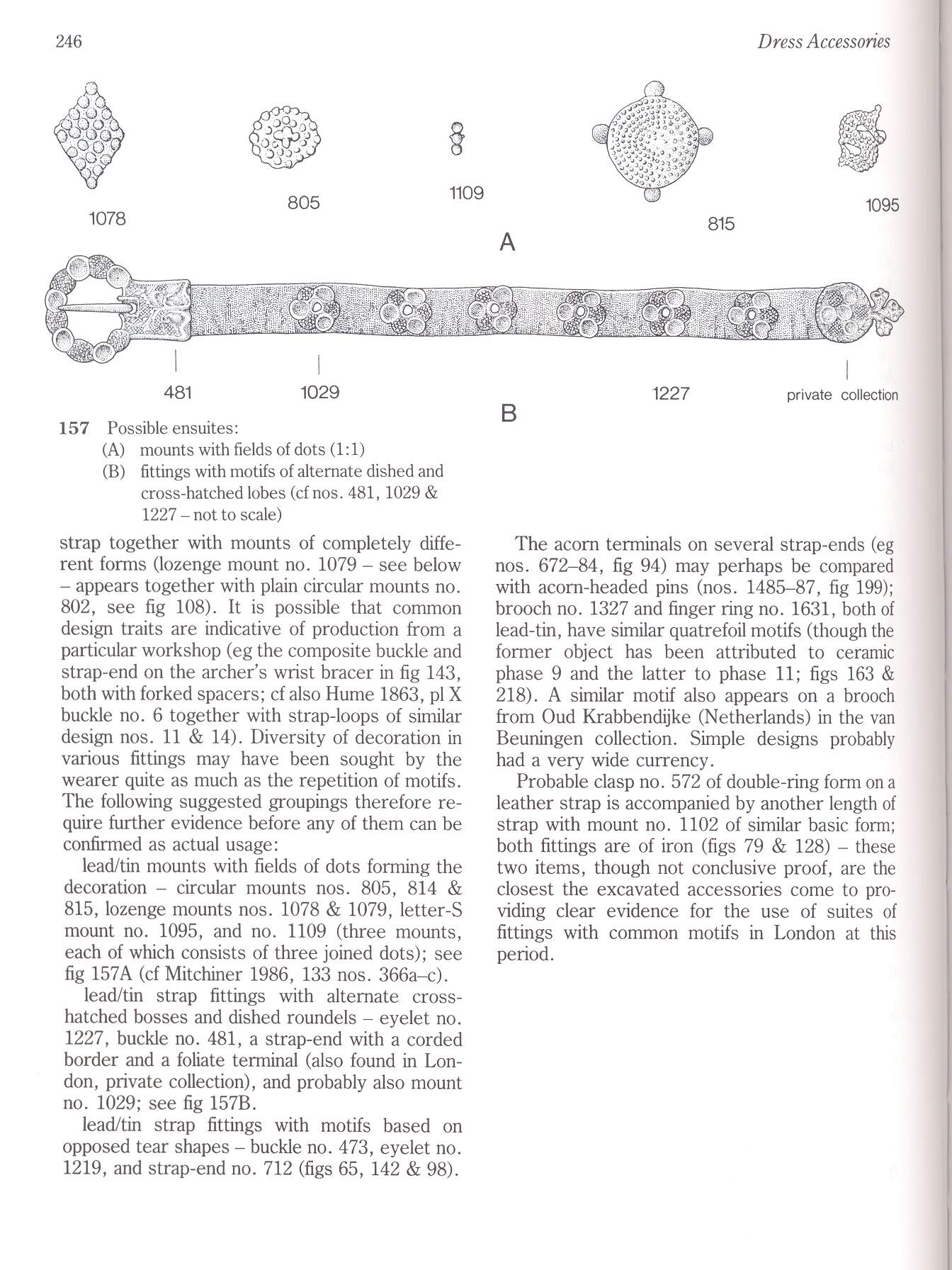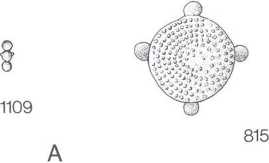274 (42)

Dress Accessońes
246

1078

805


1095

(A) mounts with fields of dots (1:1)
(B) fittings with motifs of altemate dished and cross-hatched lobes (cf nos. 481,1029 & 1227 - not to scalę)
strap together with mounts of completely diffe-rent forms (lozenge mount no. 1079 - see belo w - appears together with plain circular mounts no. 802, see fig 108). It is possible that common design traits are indicative of production from a particular workshop (eg the composite buckie and strap-end on the archer’s wrist bracer in fig 143, both with forked spacers; cf also Hume 1863, pl X buckie no. 6 together with strap-loops of similar design nos. 11 & 14). Diversity of decoration in various fittings may have been sought by the wearer quite as much as the repetition of motifs. The following suggested groupings therefore re-quire further evidence before any of them can be confirmed as actual usage: lead/tin mounts with fields of dots forming the decoration - circular mounts nos. 805, 814 & 815, lozenge mounts nos. 1078 & 1079, letter-S mount no. 1095, and no. 1109 (three mounts, each of which consists of three joined dots); see fig 157A (cf Mitchiner 1986, 133 nos. 366a-c).
lead/tin strap fittings with altemate cross-hatched bosses and dished roundels - eyelet no. 1227, buckie no. 481, a strap-end with a corded border and a foliate terminal (also found in London, private collection), and probably also mount no. 1029; see fig 157B.
lead/tin strap fittings with motifs based on opposed tear shapes - buckie no. 473, eyelet no. 1219, and strap-end no. 712 (figs 65, 142 & 98).
The acom terminals on several strap-ends (eg nos. 672-84, fig 94) may perhaps be compared with acom-headed pins (nos. 1485-87, fig 199); brooch no. 1327 and finger ring no. 1631, both of lead-tin, have similar quatrefoil motifs (though the former object has been attributed to ceramic phase 9 and the latter to phase 11; figs 163 & 218). A similar motif also appears on a brooch from Oud Krabbendijke (Netherlands) in the van Beuningen collection. Simple designs probably had a very wide currency.
Probable clasp no. 572 of double-ring form on a leather strap is accompanied by another length of strap with mount no. 1102 of similar basie form; both fittings are of iron (figs 79 & 128) - these two items, though not conclusive proof, are the closest the excavated accessories come to pro-viding elear evidence for the use of suites of fittings with common motifs in London at this period.
Wyszukiwarka
Podobne podstrony:
375 (18) 348 Dress Accessońes ribbon was then hemmed to the back of the pouch and the other oversewn
302 (41) 274 Dress Accessońes buttons of the former kind, found in Lund in Sweden). Composite sheeti
264 (42) 236 Dress Accessońes are fiat (no morę than 0.5mm thick) and are in the form of a disc with
skanuj0095 (28) 170 B. Cieślar Sprawdzenie naprężeń: 214,64<fd = 215 MPa. Oma* W, = 139,42 + 25,3
276 (40) 248 Dress Accessońes because no indication has been recognized on them of the wearer’s adhe
278 (40) 250 Dress Accessories 1314 1311 SWA81 2186 (2055) 9 fig 160 Corroded
284 (41) 256 Dress Accessońes Hooked annular brooch Copper alloy 1338 SWA81 acc. no. 1493 (context
286 (34) 258 Dress Accessońes 166 Pentagonal, hexagonal and six-lobed brooches -odginał shapes resto
292 (37) 264 Dress Accessories 1365 171 Yiolet brooches (drawings 1:1, photograph 2:1) (?)flower bud
296 (37) 268 Dress Accessońes Brooches with circular frames Leaf 1374 BC72 2037 (83) 11 fig 174 Poss
298 (39) 270 Dress Accessories Table 5 Brooches - metals used 1 1 Copper i i 2 I I I -1-1—[— 1 1 1
304 (37) 276 Dress Accessońes slightly damaged (an impressed dot here may not be an original feature
306 (35) 180 180 278 Dress Accessońes Cloth buttons and corresponding holes on a sleeve from a depos
308 (39) 280 Dress Accessońes late 13th century onwards. The alloys used in buttons prior to that co
310 (36) 282 182 Lace chapes: terminology Dress Accessories O edge to edge seam overlapping seam end
312 (36) 284 Dress Accessories O /v- <& © - O 1428 1406 0 184 Lace chapes (1:1) 1426
314 (34) 286 Dress Accessońes one side ending in chapes, wom by a woman. Pourpoints and aketons (bot
318 (36) 290 Dress Accessories one has a tiny spoon at the opposite end from the nib, though MoL acc
więcej podobnych podstron